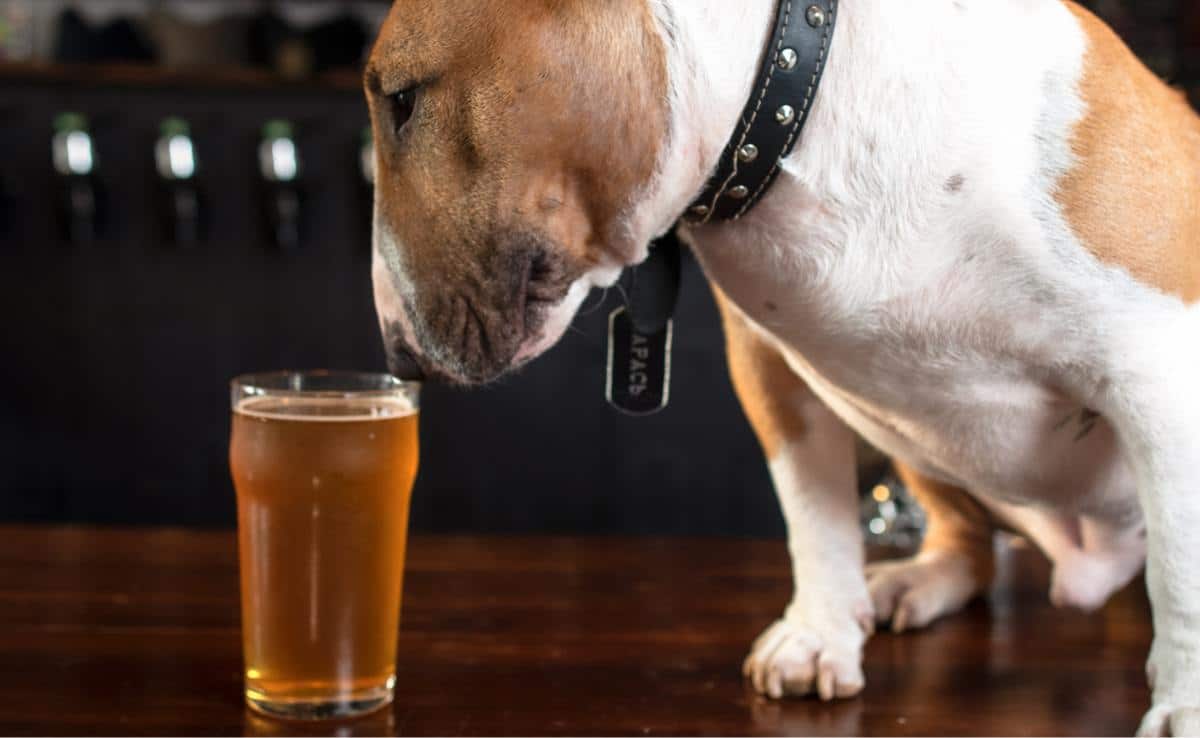Border Collie Feeding Chart: How Much To Feed Your Border Puppy
When you purchase through links on our site, we may earn a commission. Here’s how it works.
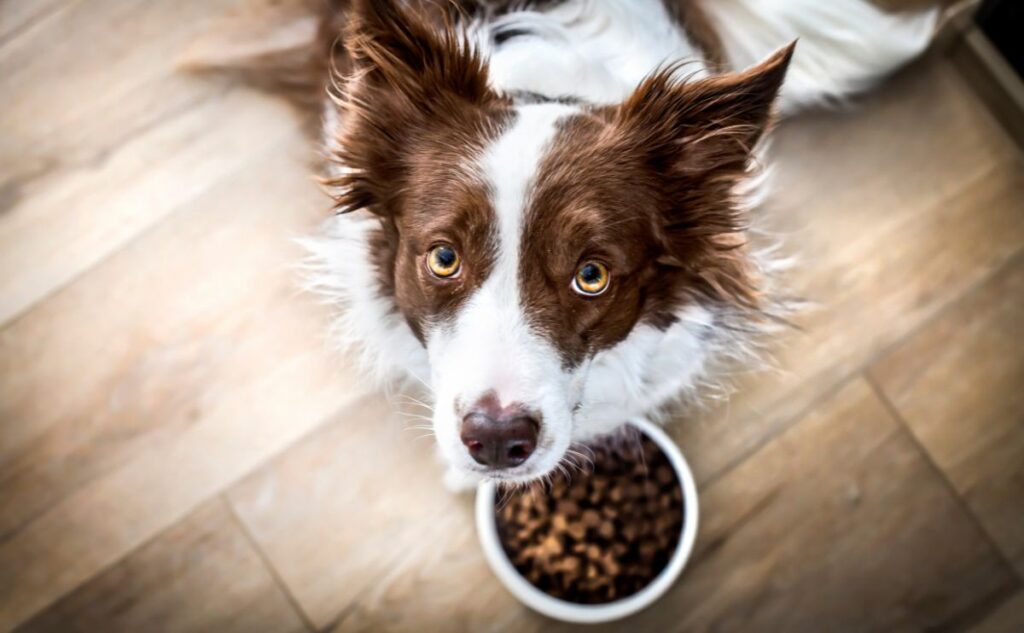
Border Collies are high-energy, intelligent dogs that thrive on the proper nutrition. But how much should a Border Collie eat to stay healthy and full of energy? Feeding too little can leave them sluggish, while overfeeding can lead to obesity and health problems. Finding the perfect balance is key, but with so many factors—age, weight, activity level—it’s not always easy to figure out the right portions.
Table of Contents
If you’ve just brought home a Border Collie puppy, you need to know exactly how much and how often to feed them. Using a Border Collie puppy feeding chart takes the guesswork out of meal planning, ensuring your pup gets the proper nutrients at every stage of growth.
Puppies burn through calories fast and need frequent, balanced meals to support their development. Without adequate nutrition, they won’t have the energy to learn, play, and grow into strong, healthy adults.
But feeding doesn’t stop being important after puppyhood. Adult and senior Border Collies have different dietary needs, depending on their activity levels and metabolism. Whether your dog is a hard-working herder or a laid-back companion, their diet should keep them lean, strong, and ready for adventure. In this guide, I’ll cover exactly how much a Border Collie should eat, provide a Border Collie feeding chart, and share expert tips to keep your dog thriving.
Border Collie Feeding Chart By Age & Weight
| Age | Weight (lbs) | Type Of Food | Calories | Meals Per Day |
|---|---|---|---|---|
| 0-3 weeks | 0.5-3 | Mother’s milk | 100-300 | Unlimited |
| 3-4 weeks | 2-5 | Mother’s milk and mush | 250-450 | Unlimited |
| 4-6 weeks | 3-8 | Mother’s milk and mush | 350-600 | 4-6 |
| 6-8 weeks | 5-10 | Mother’s milk and puppy diet | 500-700 | 4-6 |
| 8 weeks to 6 months | 10-25 | Puppy diet | 600-1,500 | 3-4 |
| 6-9 months | 20-35 | Puppy diet | 1,200-1,800 | 2-3 |
| 9-12 months | 25-45 | Puppy diet | 1,400-2,000 | 2 |
| 12-18 months | 30-55 | Puppy or adult diet | 1,500-2,400 | 1-2 |
How Much To Feed A Border Collie Puppy

Bringing home a Border Collie puppy is an exciting journey, but ensuring they get the right nutrition is essential for their growth, energy, and overall health. These intelligent and active dogs develop rapidly in their first year, requiring a carefully balanced diet at each stage. From relying solely on their mother’s milk in the first few weeks to transitioning to solid food and eventually an adult diet, correctly feeding your puppy will set them up for a long and healthy life.
Understanding how much to feed a Border Collie puppy can be tricky, as their needs change with age, weight, and activity level. To help you navigate this crucial stage, we’ve broken down their feeding requirements into key growth phases. Here’s everything you need to know about feeding your Border Collie puppy from birth to 18 months.
Weeks 0 – 3
During the first three weeks of life, a Border Collie puppy depends entirely on mother’s milk. Milk provides all the essential nutrients, antibodies, and hydration needed for proper development. Puppies in this stage are small and fragile, weighing under three pounds, and their primary focus is nursing, sleeping, and growing.
Since they cannot regulate their body temperature well, they rely on their mother for warmth. Their feeding schedule is completely instinctual, nursing whenever they need. If the mother is unavailable, a puppy milk replacer should be used, with feedings given every two to three hours to ensure they get enough nutrition to support their rapid growth.
Weeks 3 – 4
At around three weeks, a Border Collie puppy’s senses become more developed, and they start exploring their surroundings. This is when they begin transitioning from an all-milk diet to soft, mushy foods. Their weight increases to about two to five pounds, and their energy levels start rising.
Introduce a puppy mush made from high-quality puppy food blended with warm water or a puppy milk replacer. Offer small amounts three to four times per day, but allow them to continue nursing as well. They also begin teething at this stage, so soft foods help them adjust to chewing.
Weeks 4 – 6
A Border Collie puppy becomes more active and playful by four weeks old. Their weight ranges from three to eight pounds, and they rely less on their mother’s milk. Weaning progresses naturally, with puppies occasionally eating more solid food while still nursing.
Offer four to six small meals daily, gradually thickening the puppy mush until they can handle dry or moistened kibble. Choose a high-protein, high-calorie puppy food to support their fast-growing bones and muscles. Monitor their stool consistency to ensure they digest food properly, as sudden dietary changes can lead to tummy upsets.
Weeks 6 – 8
At this stage, puppies are transitioning to a 100% solid diet. Most puppies are fully weaned to solid food between seven and 10 weeks, although the transition can occur earlier. Puppies typically weigh between five to 10 pounds and have abundant energy, requiring a proper diet to sustain their rapid growth. Feed them a high-quality puppy-specific diet for medium-sized, active breeds like Border Collies.
They should receive four to six meals daily, as their small stomachs cannot hold large amounts of food at once. This period is crucial for socialization and training, so providing balanced nutrition will help support brain development and learning ability. Keep an eye on their weight; some puppies may need slightly more or less food depending on their metabolism and activity level.
8 Weeks – 12 Months
By eight weeks, Border Collie puppies are ready to join their new homes. Their weight can range from 10 to 25 pounds, depending on genetics and diet. They require three to four meals per day, consisting of puppy food rich in protein and healthy fats, to support their high energy levels.
During this stage, puppies experience growth spurts and may have fluctuating appetites. Always adjust portion sizes based on activity levels—high-energy puppies may require up to 2,000 calories daily. Keep an eye on their body condition and avoid overfeeding, as excess weight can strain their developing joints.
12 – 18 Months
At 12 months, most Border Collies weigh between 30 to 55 pounds, though some may continue growing until 18 months. Their metabolism begins to slow slightly, so they no longer need as many daily meals. Transition them to one or two meals daily while monitoring portion sizes to maintain a lean and athletic build.
By now, they should switch to a high-quality adult dog food designed for active breeds. If they are working or highly active dogs, they may still need a diet rich in protein and fat to sustain their energy levels. Keep fresh water available at all times, and continue adjusting their food intake based on their activity and weight.
Feeding Schedule For Border Collies
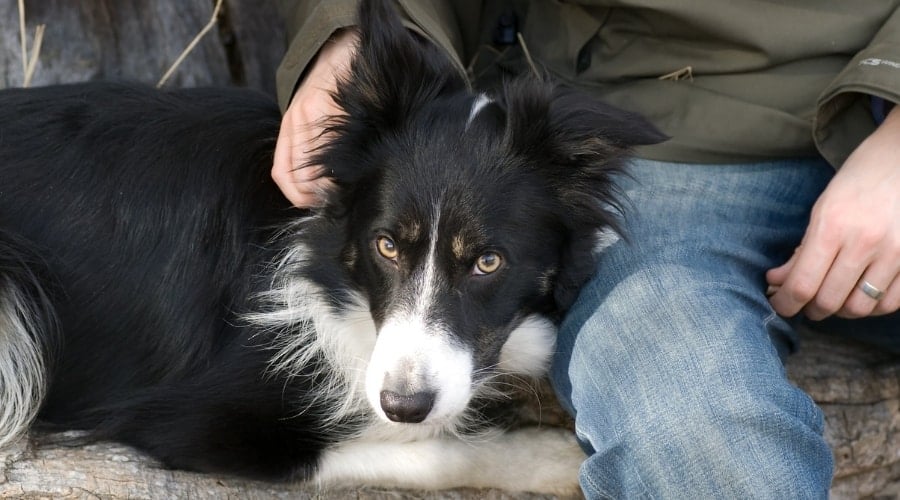
A consistent feeding schedule is the foundation of your Border Collie’s health and well-being. These highly intelligent, energetic dogs thrive on routine, so sticking to a predictable feeding plan helps regulate digestion, maintain energy levels, and support overall health.
Puppy Feeding Schedule
Border Collie puppies grow rapidly and have boundless energy, requiring frequent meals packed with essential nutrients. Aim to feed your pup three to four times daily to meet their high metabolic needs. An example feeding schedule for puppies may be 7 am, noon, and 5 pm.
Try to keep the final feeding around the 5 o’clock mark so that your puppy has ample time to digest their food and eliminate it before bedtime.
Adult Border Collie Feeding Schedule
As your Border Collie matures, their metabolism slows slightly, but they still require a balanced diet to support their high activity levels. Most adult Border Collies do best with two meals per day:
- Morning (7:00-8:00 pm): Breakfast to kickstart their energy for the day
- Evening (5:00-6:00 pm): Dinner to refuel after exercise and training
Keep the last meal no later than 6:00 pm, giving your Border Collie plenty of time to digest and relieve themselves before bedtime.
Puppy Food vs Adult Food
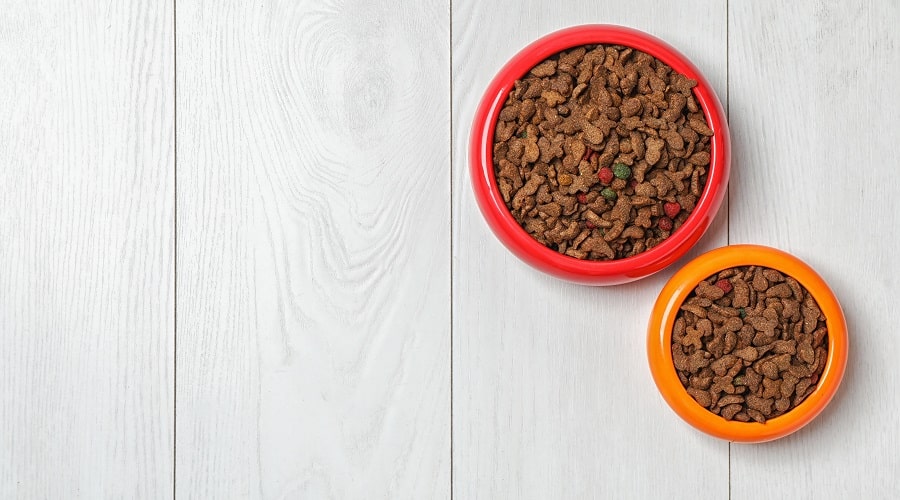
Choosing the right food for your Border Collie at each life stage is crucial for proper growth, muscle development, and sustained energy.
Key Differences Between Puppy And Adult Formulas
- Caloric content: Border Collie puppies are growing rapidly and are constantly on the move. Their food must be higher in calories per pound of body weight to support muscle growth, brain development, and playtime energy.
- Protein content: Protein is the building block of strong muscles, and an active breed like the Border Collie needs plenty of it. Puppy formulas typically contain more protein, which is essential for muscle and tissue development.
- Fat content: Border Collie puppies are highly active, so their diet should include higher fat content for sustained energy. Look for foods rich in DHA (docosahexaenoic acid), an omega-3 fatty acid that promotes brain development, sharpens cognitive function, and enhances vision—critical for a breed known for intelligence and problem-solving.
- Vitamins and minerals: Puppy-specific foods contain elevated levels of calcium, phosphorus, and other vital nutrients to support bone growth and joint health, preparing them for their high-energy adult lifestyle.
Why Adult Border Collies Shouldn’t Eat Puppy Food
While puppy food is designed to fuel rapid growth, it contains more calories and fat than an adult Border Collie needs. Feeding an adult dog puppy food can lead to excessive weight gain, which can negatively impact their agility and overall health. Border Collies are naturally lean and athletic—overfeeding them with calorie-dense puppy food can increase the risk of obesity and joint issues.
When transitioning from puppy to adult food (typically around 12-14 months old), choose a high-quality, protein-rich formula that supports their active lifestyle.
Different Types Of Dog Food
Below are the current diet options available for puppies and adult dogs.
Dry Food (Kibble)

Dry kibble is one of the most common types of dog food for Border Collie owners, offering a host of benefits that make feeding simple and convenient. It’s easy to store, doesn’t require refrigeration, and can often be bought in bulk, making it an economical choice for many pet parents. Commercial dry kibble is formulated to be nutritionally complete and balanced for canines of all life stages. As commercial recipes are regulated by the Food and Drug Administration (FDA), kibble manufacturers must adhere to strict guidelines to ensure each formula provides the essential nutrients your dog needs.
When reading a bag of kibble, you’ll notice the ingredients listed in order of weight, from most to least. A guaranteed analysis will also be included, which breaks down the crude protein, fat, fiber, and moisture percentages. This gives pet owners a clear idea of what their dog is getting in every meal.
One of the most significant selling points of dry kibble is its versatility. When feeding time arrives, you can simply serve the kibble as-is, allowing your Border Collie to enjoy its crunchy texture, which may help reduce plaque build-up and keep their teeth cleaner. You can also mix in a little water or bone broth for added hydration or flavor. Some owners like to add wet food or other toppings for variety, making mealtime an enjoyable experience for their pets.
Keep in mind that not all kibble is created equal. Many commercial kibble brands contain questionable ingredients. Unhealthy fats, low-quality protein sources, and grains or fillers that don’t serve a beneficial purpose are all common culprits. By reading ingredient lists and researching the quality of the kibble you buy, you can ensure your Border Collie is getting the best nutrition possible from their food.
Wet Food (Canned)

Whether packaged in cans or pouches, commercial wet food is widely available and comes in a vast array of options. Wet food is typically more appetizing to dogs than kibble, thanks to its strong aroma and tender texture, making it an appealing choice for dogs with sensitive palates. Additionally, wet food generally boasts higher protein and fat content while being lower in carbohydrates compared to dry kibble, making it an excellent option to support your Border Collie’s nutritional needs.
One of the standout features of wet dog food is its high moisture content, which can benefit your Border Collie’s overall health. Since these dogs are naturally very active, they require adequate hydration to maintain stamina and prevent dehydration. Wet food can help supplement their water intake, ensuring they stay hydrated and energized.
However, wet food can also come with some downsides. It tends to be lower in calories than kibble, which means your Border Collie may need to eat more to meet their daily caloric requirements. Additionally—just as with kibble—some wet food options are loaded with fillers, artificial preservatives, and low-quality proteins, which may not be the best choice for your Border Collie’s health. Always scrutinize the ingredient list to ensure you’re selecting a nutritious option that provides the essential nutrients your dog needs.
When purchasing wet food, it’s crucial to choose options that come in BPA-free containers. Bisphenol A (BPA) is a chemical commonly found in the lining of cans, and it can leach into the food, posing potential health risks. BPA is a known endocrine disruptor and has been linked to various health problems in both humans and dogs, including cancer, diabetes, heart and kidney disease, as well as thyroid and reproductive disorders. To avoid these risks, always check the packaging for BPA-free labeling.
Fresh (Human-Grade)

The rise of human-grade dog food has come in response to growing demand for high-quality, fresh options for pets. Unlike traditional feed-grade commercial dog food, makers of human-grade dog foods claim they manufacture their products in accordance with human food regulations. As a result, their food excludes by-products, chemicals, fillers, or “4D meats”—those sourced from animals that were “dead, dying, diseased, or down” and processed at rendering plants.
Many companies also focus on reducing their environmental impact by sourcing ingredients from sustainable farms and minimizing waste in production. They often adhere to high animal welfare standards, ensuring that meat and other ingredients are responsibly sourced. For pet owners concerned about the broader impact of their purchases, this ethical commitment is important.
Note: The term “human-grade” is not officially regulated, so its use can be misleading. The Association of American Feed Control Officials (AAFCO) has established voluntary guidelines, but there’s no formal oversight. Pet owners must be diligent when choosing a brand, ensuring they follow the best sourcing, processing, and packaging practices.
Always read the ingredient list to ensure you’re choosing the best food for your Border Collie. Look for transparency in sourcing and a commitment to third-party quality control, which helps ensure the food’s quality and safety.
A major downside of human-grade dog food is the cost. Premium ingredients and superior production methods lead to a price premium over traditional kibble or high-quality wet food. Border Collie owners may need to feed larger portions due to their high energy needs, making it expensive. Additionally, because human-grade food often contains fresher, perishable ingredients, it may spoil faster, requiring careful storage and quicker use to avoid waste.
Home Cooked

Before the rise of commercial dog food, our furry companions often ate the same foods as their owners. The Pet Food Institute highlights that early dog owners typically fed their pets table scraps or whatever leftovers were available. While our understanding of animal science has evolved to meet our puppy’s nutritional needs better, there’s still merit to feeding our dog home-cooked meals.
Interestingly, some of the longest-living dogs in history had remarkably different diets, yet all shared one key element: real, fresh ingredients. Bramble, a Border Collie who reached 25 years old, thrived on a plant-based diet of rice, lentils, and vegetables. Alternatively, Chanel, a Dachshund who lived to an impressive 21 years old, ate home-cooked chicken as part of her diet.
These examples show that fresh food—whether plant- or animal-based—can benefit a dog’s diet. For pet owners, home cooking offers ultimate control over what their dog eats. This can be especially important for highly energetic dogs, who need precise nutrition to fuel their athleticism. However, creating balanced home-cooked meals requires careful planning and preparation to ensure your dog gets all the necessary nutrients, including vitamins, minerals, and protein.
Raw, Prey Model, Or Biologically Appropriate Raw Food (BARF)

Raw feeding, often called the Prey Model or BARF (Biologically Appropriate Raw Food) diet, is based on the idea that dogs, like their wild ancestors, should consume a species-appropriate diet of raw meat, bones, and natural ingredients. For active dogs like Border Collies, the raw diet offers benefits such as better digestion, improved coat quality, and enhanced energy levels.
The Prey Model focuses on simplicity, mimicking a wild dog’s diet. Meals typically consist of 80% muscle meat, 10% bone, 5% liver, and 5% other secreting organs. For the BARF Diet, the proportions are 70% muscle meat, 10% edible bones, 7% vegetables, 5% liver, 5% other secreting organs, 2% seeds or nuts, and 1% fruit. These ratios aim to replicate the natural, nutrient-dense foods wild canines consume, providing a balanced diet.
Despite its benefits, there are some things to consider before switching your Border Collie to a raw food diet. One key drawback is the cost; raw diets can be more expensive than traditional kibble or canned food. If you prepare the meals yourself, there’s a risk of creating unbalanced meals that could lead to nutrient deficiencies and health issues for your dog.
Another concern is the potential for bones in raw food to cause blockages or injury if not handled properly. Additionally, raw food can carry a higher risk of contamination from harmful bacteria, which can be dangerous for your dog and humans.
To minimize these risks, consider commercially prepared raw food. These meals are carefully balanced to ensure your dog gets all the necessary nutrients while reducing the chances of contamination or improper food handling, offering a safer alternative to homemade meals.
Vegan Diet

The vegan diet for dogs is an increasingly popular choice for pet owners who prefer plant-based feeding options or are motivated by ethical or environmental reasons. When properly formulated, a vegan diet can give your Border Collie the essential nutrients they need to thrive.
A vegan diet for dogs eliminates animal products like meat, poultry, and fish, replacing them with plant-based proteins from sources like lentils, chickpeas, quinoa, and peas. In addition to plant proteins, a vegan dog diet includes vegetables, fruits, grains, and plant-based fats such as flaxseed or coconut oil. For Border Collies, whose high activity levels demand a lot of energy, the key is ensuring they get a balanced diet that includes adequate protein, fats, vitamins, and minerals.
The main benefits of a vegan diet for your Border Collie can include:
- Ethical choice: A plant-based diet aligns with the values of many pet owners who are concerned about animal welfare or the environmental impact of animal farming.
- Reduced risk of food allergies: Since vegan diets typically contain fewer common allergens like beef, chicken, and dairy, they may benefit dogs with food sensitivities.
- Weight management: Vegan diets tend to be lower in calories and fat, which can be helpful for dogs prone to obesity or those in need of weight management.
- Healthier skin and coat: Plant-based ingredients can provide healthy fats that improve skin and coat quality.
While there are benefits to a vegan diet, there are also some drawbacks, particularly for a high-energy breed like the Border Collie. One major challenge is ensuring that the diet meets all their nutritional needs, especially since dogs require certain nutrients typically found in animal products. To avoid deficiencies, supplementing or buying a recipe that includes these vitamins, minerals, and amino acids in their synthetic form is essential.
Importance Of High-Quality Dog Food
| Fresh (All Life Stages) | Puppies | Adult Dry | Adult Wet | Seniors |
|---|---|---|---|---|
 | 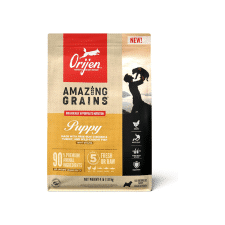 | 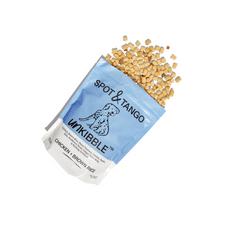 | 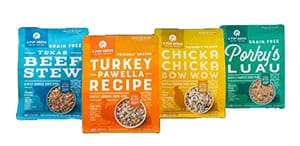 | 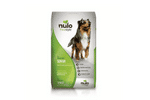 |
| The Farmer’s Dog | Orijen | Spot & Tango | A Pup Above | Nulo |
| Visit Website | View on Chewy | Visit Website | Visit Website | View on Chewy |
| Read Review | Read Review | Read Review | Read Review | Read Review |
Diet plays a massive role in your dog’s overall health, regardless of whether you choose raw, vegan, commercial, or homecooked meals. A balanced, high-quality diet provides essential nutrients that support your dog’s immune system, boost energy levels, improve mood, and reduce the risk of lifestyle-related diseases like heart disease and diabetes. A well-rounded diet not only helps your dog maintain a healthy weight and promotes better digestion but also supports their vitality, ensuring they remain active and happy for years to come.
A healthy diet can even help prevent hereditary diseases through gene regulation. Proper nutrition influences which genes are expressed in your dog’s body, turning on “good genes” that promote health and wellness while turning off “bad genes” that could lead to disease. For breeds like Border Collies, who are predisposed to certain health conditions, feeding a high-quality, balanced diet may help delay or reduce the impact of these health risks.
Ingredients To Avoid In Dog Food
- BHA, BHT, and Ethoxyquin: These synthetic preservatives are used to extend the shelf life of pet food. Though the FDA deems BHA and BHT as “generally recognized as safe,” they have been linked to cancer in animal studies, raising concerns about their safety. The Center for Science in the Public Interest recommends avoiding BHA and advises caution with BHT. Ethoxyquin, another synthetic antioxidant, is banned in human food but is still allowed in pet food despite evidence of harmful effects on both animals and humans.
- Artificial food dyes: Caramel coloring, commonly used in pet food, contains 4-methylimidazole (4-MIE), which is known to be a carcinogen in animals.
- Unnamed meat and bone meal: Meat meals and by-products are often derived from the rendering process, which can include animal remains from various sources, such as animal shelters, farms, and slaughterhouses. These unspecific meat and bone sources can be a health concern for pets, as the quality and safety of these ingredients are not always clear.
- Propylene glycol: This humectant keeps semi-moist foods moist. It is derived from ethylene glycol (EG), aka antifreeze, which is extremely toxic to animals. The FDA prohibits propylene glycol from being in cat food but allows it to be in dog food.
- Rendered fat: While rendered fat adds flavor to kibble, it can also be a potential source of harmful bacteria and toxins. The process of rendering is minimally regulated, which means that the fat may contain contaminants that could negatively affect your dog’s health.
What Nutrients Do Border Collie Puppies Need?
Your puppy requires six key nutrients to thrive: protein, fats, carbohydrates, vitamins, minerals, and water. The AAFCO sets guidelines for dog nutrition, which are available on its website. Below, we’ve outlined the minimum nutritional requirements for both puppies and adult dogs, highlighting the differences in their needs for essential nutrients that support growth and development.
Protein
Protein is an essential energy source for dogs and plays a critical role in various bodily functions, such as:
- Maintaining body structure, strength, and elasticity
- Regulating fluid balance
- Supporting tissue growth and maintenance
- Facilitating hormone signaling
- Boosting immune health
- Aiding in nutrient transport and storage
- Helping maintain pH balance
Protein can come from both animal and plant-based sources. Animal-sourced proteins are considered “complete” because they contain all the essential amino acids your pup needs without requiring a mix of different protein sources (though some plant proteins, like quinoa and soybeans, are also complete).
Fat
Fat is the second most important macronutrient for dogs, providing energy and performing several essential functions:
- Helping absorb fat-soluble vitamins (A, D, E, and K) in the intestines
- Supporting hormone production
- Protecting organs
- Insulating the body to regulate temperature
Good sources of fats for dogs include:
- Chicken fat: An unsaturated fat that provides omega-3 and omega-6 fatty acids. It’s high in LA, which supports healthy skin and coat.
- Beef tallow (preferably grass-fed): A saturated fat that contains CLA (conjugated linoleic acid), known for its anti-inflammatory properties.
- Flaxseed or flaxseed oil: Rich in polyunsaturated fatty acids, particularly ALA, an omega-3 fatty acid that can be converted to EPA and DHA.
- Fish oil (from anchovies, sardines, salmon, etc.): A rich source of omega-3s EPA and DHA, which support immune health, reduce inflammation, and benefit brain and eye health.
Carbohydrates
Though the AAFCO does not set specific guidelines for carbohydrate intake, this macronutrient can still benefit your dog’s health:
- Complex carbohydrates provide essential nutrients, including antioxidants, fatty acids, fiber, vitamins, and minerals.
- Fiber in carbs helps manage weight by promoting satiety and stabilizing blood sugar levels, playing a role in preventing and managing diabetes.
- Fiber also aids in maintaining regular bowel movements and supports gut health by feeding beneficial bacteria, which play a vital role in immunity, digestion, and even mood.
Fruits and vegetables are great sources of carbohydrates for dogs. Think apples, blueberries, broccoli, carrots, pumpkin, spinach, etc.
Vitamins & Minerals
Vitamins are organic compounds needed for cellular growth, function, and development. Minerals are natural elements essential for your dog’s development and bodily functions. Both vitamins and minerals are required in varying amounts.
Water
Water is critical for all metabolic processes in the body. Its benefits are extensive:
- Assisting in digestion and nutrient absorption
- Transporting nutrients in and out of cells
- Cushioning the brain and spinal cord
- Lubricating joints
- Regulating body temperature
As a general rule, your dog should drink about one ounce of water per pound of body weight each day.
Keeping Your Border Collie At The Right Weight

Maintaining a healthy weight is essential for your Border Collie’s overall health and longevity. As an active, high-energy breed, it’s important to ensure they receive the right nutrition and exercise balance to keep them happy and healthy. Here are some tips to help you keep your Border Collie at an optimal weight.
Portion Control
Ensure you’re feeding your Border Collie the correct amount based on their age, weight, and activity level. Overfeeding is a common cause of weight gain. Check the feeding guidelines on your dog’s food packaging, but adjust portions based on your dog’s specific needs. If you’re unsure, consult your veterinarian for guidance on how much food your dog should be eating daily.
Quality Diet
Feed your Border Collie high-quality, balanced meals rich in protein, healthy fats, and fiber. Opt for nutrient-dense foods that will keep them satisfied and provide energy without excess calories. Avoid fillers like corn, soy, and by-products, as they can lead to weight gain without providing nutritional value.
Regular Exercise
Border Collies are known for their intelligence and energy levels, so regular exercise is crucial. Aim for at least an hour of vigorous activity daily, such as running, playing fetch, or engaging in agility training. Consistent exercise helps burn calories and maintains muscle mass, preventing weight gain.
Monitor Treats And Snacks
While treats are great for training and bonding, they can add up quickly in terms of calories. Be mindful of the type and number of treats you give your dog. Avoid feeding table scraps or human food, which may be high in fats and sugars.
Weigh Regularly
Keep track of your Border Collie’s weight by weighing them regularly. This will help you spot any changes early on and take action before they gain excess weight. If you notice your dog is gaining or losing weight, adjust their diet and exercise routine accordingly.
Avoid Free Feeding
Free feeding (leaving food out all day) can lead to overeating. Set specific feeding times and remove any leftover food after 15-20 minutes. This helps regulate your dog’s food intake and ensures they only eat what’s necessary.
Adjust For Life Stage
Border Collies have different nutritional needs at various stages of life. Puppies, adults, and senior dogs all have varying activity levels and metabolism rates. Ensure you are feeding food that’s appropriate for your dog’s life stage to prevent overfeeding or underfeeding.
Consult Your Veterinarian
If you are concerned about your Border Collie’s weight or health, consult your veterinarian. They can assess your dog’s condition, recommend a personalized diet plan, and ensure no underlying health issues contribute to weight changes.
Frequently Asked Questions
We’ve received various questions from our readers about feeding Border Collies, and we have answered those questions here. Don’t see yours? Ask us in the comments.
Is It Safe To Feed My Border Collie Human Food?
While some human foods are safe for dogs in small amounts (like cooked lean meats or certain fruits), many human foods can be toxic to Border Collies. Check out our guide on human foods that are dangerous for dogs.
How Do I Transition My Border Collie To A New Food?
When transitioning your Border Collie to a new food, do it gradually over 7-10 days to avoid digestive upset. Start by mixing 25% of the new food with 75% of the current food, gradually increasing the new food while decreasing the old food each day. This gentle transition will allow your dog’s digestive system to adjust to their new diet without causing diarrhea or vomiting.
How Can I Tell If My Border Collie Is Overweight Or Underweight?
A healthy Border Collie should have a defined waist and be able to feel their ribs without excess fat covering them. To check:
- Look from above—you should see an hourglass shape with a noticeable waist behind the ribs.
- Feel along the rib cage—you should be able to feel the ribs easily without too much fat padding.
- Check from the side—you should see a slight tuck in the abdomen.
If your dog’s ribs are hard to feel or they don’t have a visible waist, they may be overweight. If the ribs are too prominent, your dog may be underweight. Consult your vet if unsure about your dog’s weight or overall condition.
Best Dog Food For Border Collies
Now that you’ve got the feeding schedule down and understand the basics of Border Collie nutrition, you’re likely curious about which foods we recommend. Our article on the best dog food for Border Collies shares top picks for puppies, adult dogs, seniors, and beyond.
Why Trust Canine Journal?
Tara is a writer for Canine Journal, specializing in health and nutrition. She has worked in the wellness industry for 7+ years, advising pet parents on supplements and nutrition for their furry friends. Tara spends countless hours vetting companies and their products for quality, such as checking ingredient sourcing, product purity, and sustainability.


